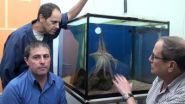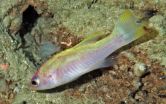(Press-News.org) Scientists have advanced a brain-scanning technology that tracks what the brain is doing by shining dozens of tiny LED lights on the head. This new generation of neuroimaging compares favorably to other approaches but avoids the radiation exposure and bulky magnets the others require, according to new research at Washington University School of Medicine in St. Louis.
The new optical approach to brain scanning is ideally suited for children and for patients with electronic implants, such as pacemakers, cochlear implants and deep brain stimulators (used to treat Parkinson's disease). The magnetic fields in magnetic resonance imaging (MRI) often disrupt either the function or safety of implanted electrical devices, whereas there is no interference with the optical technique.
The new technology is called diffuse optical tomography (DOT). While researchers have been developing it for more than 10 years, the method had been limited to small regions of the brain. The new DOT instrument covers two-thirds of the head and for the first time can image brain processes taking place in multiple regions and brain networks such as those involved in language processing and self-reflection (daydreaming).
The results are now available online in Nature Photonics.
"When the neuronal activity of a region in the brain increases, highly oxygenated blood flows to the parts of the brain doing more work, and we can detect that," said senior author Joseph Culver, PhD, associate professor of radiology. "It's roughly akin to spotting the rush of blood to someone's cheeks when they blush."
The technique works by detecting light transmitted through the head and capturing the dynamic changes in colors of the brain tissue.
Although DOT technology now is used in research settings, it has the potential to be helpful in many medical scenarios as a surrogate for functional MRI, the most commonly used imaging method for mapping human brain function.
Functional MRI also tracks activity in the brain via changes in blood flow. In addition to greatly adding to our understanding of the human brain, fMRI is used to diagnose and monitor brain disease and therapy.
Another commonly used method for mapping brain function is positron emission tomography (PET), which involves radiation exposure. Because DOT technology does not use radiation, multiple scans performed over time could be used to monitor the progress of patients treated for brain injuries, developmental disorders such as autism, neurodegenerative disorders such as Parkinson's, and other diseases.
Unlike fMRI and PET, DOT technology is designed to be portable, so it could be used at a patient's beside or in the operating room.
"With the new improvements in image quality, DOT is moving significantly closer to the resolution and positional accuracy of fMRI," said first author Adam T. Eggebrecht, PhD, a postdoctoral research fellow. "That means DOT can be used as a stronger surrogate in situations where fMRI cannot be used."
The researchers have many ideas for applying DOT, including learning more about how deep brain stimulation helps Parkinson's patients, imaging the brain during social interactions, and studying what happens to the brain during general anesthesia and when the heart is temporarily stopped during cardiac surgery.
For the current study, the researchers validated the performance of DOT by comparing its results to fMRI scans. Data was collected using the same subjects, and the DOT and fMRI images were aligned. They looked for Broca's area, a key area of the frontal lobe used for language and speech production. The overlap between the brain region identified as Broca's area by DOT data and by fMRI scans was about 75 percent.
In a second set of tests, researchers used DOT and fMRI to detect brain networks that are active when subjects are resting or daydreaming. Researchers' interests in these networks have grown enormously over the past decade as the networks have been tied to many different aspects of brain health and sickness, such as schizophrenia, autism and Alzheimer's disease. In these studies, the DOT data also showed remarkable similarity to fMRI — picking out the same cluster of three regions in both hemispheres.
"With the improved image quality of the new DOT system, we are getting much closer to the accuracy of fMRI," Culver said. "We've achieved a level of detail that, going forward, could make optical neuroimaging much more useful in research and the clinic."
While DOT doesn't let scientists peer very deeply into the brain, researchers can get reliable data to a depth of about one centimeter of tissue. That centimeter contains some of the brain's most important and interesting areas with many higher brain functions, such as memory, language and self-awareness represented.
During DOT scans, the subject wears a cap composed of many light sources and sensors connected to cables. The full-scale DOT unit takes up an area slightly larger than an old-fashioned phone booth, but Culver and his colleagues have built versions of the scanner mounted on wheeled carts. They continue to work to make the technology more portable.
INFORMATION:
Culver and Washington University have financial interests in Cephalogics LLC based on a license of related optical imaging technology by the university to Cephalogics LLC. They are regulated in accordance with the university's conflict-of-interest policies.
The research is funded by the National Institutes of Health (NIH) grants R01-EB009233, R01-NS078223, T32-NS007205-30 and P30-NS048056; an Autism Speaks Postdoctoral Translational Research Fellowship; a Fulbright Science and Technology PhD Award; and a McDonnell Centre for Systems Neuroscience grant.
Eggebrecht AT, Ferradal SL, Robichaux-Viehoever A, Hassanpour MS, Dehghani H, Snyder AZ, Hershey T, Culver JP. Mapping distributed brain function and networks with diffuse optical tomography. Nature Photonics. Online May 18, 2014.
Washington University School of Medicine's 2,100 employed and volunteer faculty physicians also are the medical staff of Barnes-Jewish and St. Louis Children's hospitals. The School of Medicine is one of the leading medical research, teaching and patient-care institutions in the nation, currently ranked sixth in the nation by U.S. News & World Report. Through its affiliations with Barnes-Jewish and St. Louis Children's hospitals, the School of Medicine is linked to BJC HealthCare.
Optical brain scanner goes where other brain scanners can't
2014-05-19
ELSE PRESS RELEASES FROM THIS DATE:
Skunk Fire, Arizona
2014-05-19
The Skunk Fire continues to burn on the San Carlos Apache Reservation in southeastern Arizona and NASA's Aqua satellite captured an image of the smoke on May 17 at 20:15 UTC (4:15 p.m. EDT/1:15 p.m. MST). A Fire Weather Watch has been posted for the region for May 20.
The Moderate Resolution Imaging Spectroradiometer or MODIS instrument that flies aboard NASA's Aqua satellite captured this photograph of the smoke. The extent of the fire (the heat) is outlined in red in this image).
According to Inciweb, the multi-U.S. agency Incident Information System website that ...
Gastroenterology highlights new microbiome research
2014-05-19
Bethesda, MD (May 19, 2014) — The editors of Gastroenterology, the official journal of the American Gastroenterological Association (AGA) Institute, are pleased to announce the publication of this year's highly anticipated special 13th issue on the intestinal microbiome, which is considered one of the hottest areas of science today.
"We are beginning to understand the ways by which the microbial environment of the gut may play a role in both the maintance of human health and the development of certain diseases. Data in this special issue of Gastroenterology may lead ...
Liberating devices from their power cords
2014-05-19
Imagine a future in which our electrical gadgets are no longer limited by plugs and external power sources.
This intriguing prospect is one of the reasons for the current interest in building the capacity to store electrical energy directly into a wide range of products, such as a laptop whose casing serves as its battery, or an electric car powered by energy stored in its chassis, or a home where the dry wall and siding store the electricity that runs the lights and appliances.
It also makes the small, dull grey wafers that graduate student Andrew Westover and Assistant ...
Having and raising offspring is costly phase of life for baboon moms
2014-05-19
Observations made over the past 29 years in Kenya as part of one of the world's longest-running studies of a wild primate show how having offspring influences the health of female baboons. These observations highlight that females are mostly injured on days when they are likely to conceive. In addition, injuries heal the slowest when they are suckling their young. The study, published in Springer's journal Behavioral Ecology and Sociobiology, is led by Elizabeth Archie of the University of Notre Dame in the US and the National Museums of Kenya.
Reproduction can be dangerous ...
UT Dallas lab eliminates rare metals in electric motors
2014-05-19
A team from the Renewable Energy and Vehicular Technology Laboratory(REVT) at UT Dallas was one of a few research groups selected for advanced participation in a Department of Energy conference aimed at presenting the next generation of energy technologies.
The DOE's Advanced Research Projects Agency-Energy (ARPA-E) program hosts an annual summit in Washington, D.C., for researchers, entrepreneurs, investors, corporate executives and government officials to share transformational research funded through the program.
Dr. Babak Fahimi, professor of electrical engineering ...
Genes play key role in brain injury risk for premature babies
2014-05-19
Premature babies' risk of brain injury is influenced by their genes, a new study suggests.
Researchers have identified a link between injury to the developing brain and common variation in genes associated with schizophrenia and the metabolism of fat.
The study builds on previous research, which has shown that being born prematurely – before 37 weeks – is a leading cause of learning and behavioural difficulties in childhood.
Around half of infants weighing less than 1500g at birth go on to experience difficulties in learning and attention at school age.
Scientists ...
Engineers find way to lower risk of midair collisions for small aircraft
2014-05-19
Researchers at North Carolina State University have developed new modifications for technology that helps pilots of small aircraft avoid midair collisions. The modified tools significantly improved pilot response times in making decisions to avert crashes.
At issue are "cockpit displays of traffic information" (CDTIs). These are GPS displays used by private pilots to track other aircraft in their vicinity. However, pilots often focus on the closest aircraft on the display – a habit that can pose a significant hazard.
If the pilot of Plane A sees two planes on the CDTI, ...
How octopuses don't tie themselves in knots revealed by Hebrew University scientists
2014-05-19
An octopus's arms are covered in hundreds of suckers that will stick to just about anything, with one important exception: those suckers generally won't grab onto the octopus itself, otherwise the impressively flexible animals would quickly find themselves all tangled up.
Now, researchers from the Hebrew University of Jerusalem report that they discovered how octopuses manage this feat, even as the creatures' brains are unaware of what their arms are doing. A chemical produced by octopus skin temporarily prevents their suckers from sucking.
"We were surprised that ...
The spot-tail golden bass: A new fish species from deep reefs of the southern Caribbean
2014-05-19
Smithsonian scientists describe a colorful new species of small coral reef sea bass from depths of 182–241 m off Curaçao, southern Caribbean. With predominantly yellow body and fins, the new species, Liopropoma santi, closely resembles the other two "golden basses" found together with it at Curaçao: L. aberrans and L. olneyi.
The scientists originally thought there was a single species of golden bass on deep reefs off Curaçao, but DNA data, distinct color patterns, and morphology revealed three. The study describing one of those, L. santi—the deepest known species of ...
Neutron beams reveal how antibodies cluster in solution
2014-05-19
Scientists have used small-angle neutron scattering (SANS) and neutron spin-echo (NSE) techniques for the first time to understand how monoclonal antibodies (mAbs), a class of targeted biopharmaceuticals used to treat autoimmune disorders and cancer, dynamically cluster and move in high concentration solutions. Certain mAb cluster arrangements can thicken pharmaceutical solutions; they could thus limit the feasible concentration of injectables administered to patients around the world. The insights provided by a team of neutron scientists from the National Center of Neutron ...





